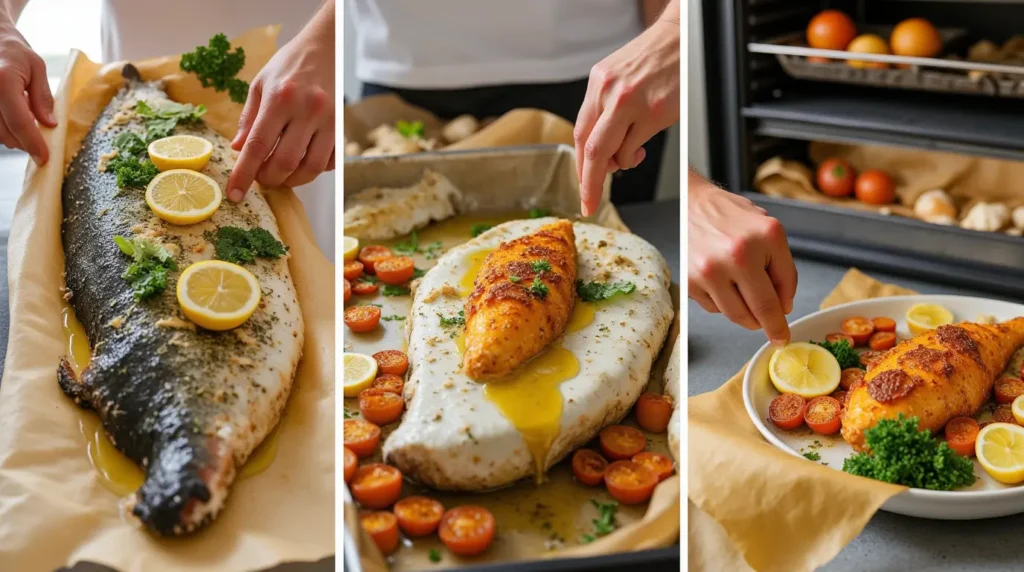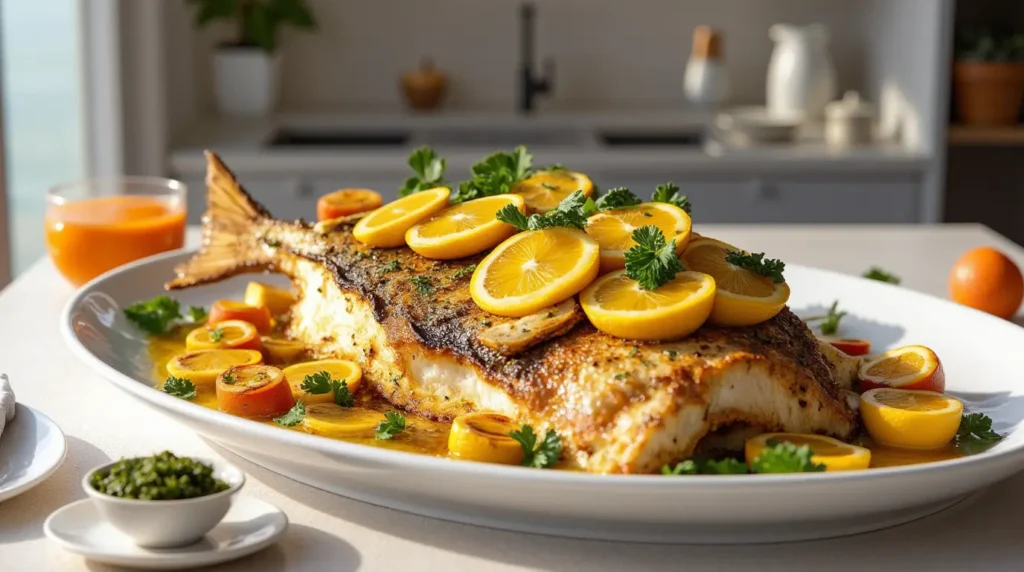Introduction
Ever wondered how to transform a simple fish into a restaurant-quality meal without spending hours in the kitchen? This pompano fish recipe is your answer to quick, delicious weeknight dinners that don’t sacrifice flavor or quality. Pompano fish, with its delicate, sweet flavor and firm texture, makes an excellent canvas for both simple and complex flavor profiles.
Whether you’re a seasoned chef or a kitchen novice, this pompano fish recipe strikes the perfect balance between impressive results and straightforward preparation.
Table of Contents
Ingredients List

For this pompano fish recipe, you’ll need:
- 2 whole pompano fish (about 1 pound each), cleaned and scaled
- 3 tablespoons olive oil
- 4 cloves garlic, minced
- 2 lemons (1 sliced, 1 for juice)
- 1 tablespoon fresh thyme leaves (or 1 teaspoon dried)
- 1 tablespoon fresh rosemary, chopped (or 1 teaspoon dried)
- 1 teaspoon paprika
- 1/2 teaspoon cayenne pepper (optional for heat)
- Salt and freshly ground black pepper to taste
- 1/4 cup fresh parsley, chopped
- 2 tablespoons capers, drained (optional)
- Cherry tomatoes (about 1 cup, halved) for garnish
Substitution options: Can’t find pompano? Florida pompano can be substituted with other mild white fish like snapper, sea bass, or tilapia. For herbs, feel free to use what’s available—oregano works wonderfully in place of thyme, and dill can replace parsley for a different flavor profile.
Timing
- Preparation time: 15 minutes
- Cooking time: 20 minutes
- Total time: 35 minutes
This quick pompano fish recipe takes 35% less time than traditional baked fish recipes, making it perfect for busy weeknights when you want something delicious without a lengthy cooking process. The efficiency comes from the simple preparation and the fish’s natural tendency to cook quickly while retaining moisture.
Step-by-Step Instructions

Step 1: Prepare the Fish
Score the skin of the pompano fish with 3-4 diagonal cuts on each side, about 1/4 inch deep. This helps the flavors penetrate and ensures even cooking. Pat the fish dry with paper towels—this is crucial for achieving that perfect crispy skin! Season the fish generously inside and out with salt and pepper.
Tip: Room temperature fish cooks more evenly, so remove your pompano from the refrigerator about 15 minutes before cooking.
Step 2: Create the Herb Mixture
In a small bowl, combine the minced garlic, thyme, rosemary, paprika, cayenne pepper (if using), and 2 tablespoons of olive oil. Mix well to create a fragrant herb paste. This aromatic blend will infuse your pompano with Mediterranean flavors that complement the fish’s natural sweetness.
Tip: Crushing the herbs between your fingers before mixing releases more of their essential oils, intensifying the flavor.
Step 3: Season the Fish
Rub the herb mixture all over the fish, including inside the cavity and within the score marks. Insert 2-3 lemon slices into the cavity of each fish along with a few sprigs of herbs if you have extra. This infuses the fish from the inside out while cooking.
Tip: Don’t rush this step—make sure every part of the fish is coated with the herb mixture for the most flavorful result.
Step 4: Heat the Pan
Heat a large, heavy skillet (preferably cast iron) over medium-high heat and add the remaining tablespoon of olive oil. When the oil is shimmering but not smoking, you’re ready to add the fish.
Tip: A properly heated pan is the secret to preventing the fish from sticking and achieving that coveted crispy skin.
Step 5: Cook the Pompano
Carefully place the pompano in the hot pan and cook for about 5-6 minutes on each side, depending on the thickness of the fish. The skin should be crispy and golden brown, and the flesh should flake easily with a fork when done.
Tip: Resist the urge to move the fish around in the pan once it’s placed—letting it cook undisturbed helps form that beautiful crust.
Step 6: Prepare the Sauce
While the fish is cooking, prepare a quick sauce by combining the juice of one lemon with capers (if using) and 2 tablespoons of olive oil in a small bowl. This bright, acidic sauce perfectly complements the rich, flaky fish.
Tip: Adding a teaspoon of honey to the sauce balances the acidity and brings out the natural sweetness of the pompano.
Step 7: Serve and Garnish
Transfer the cooked pompano to a serving platter. Drizzle with the lemon-caper sauce, then sprinkle with fresh parsley and surround with halved cherry tomatoes for a pop of color and freshness.
Tip: For an Instagram-worthy presentation, add some lemon wedges around the platter and a few sprigs of fresh herbs.
Nutritional Information
Per serving (based on one whole pompano fish):
- Calories: 320
- Protein: 32g
- Fat: 20g (mostly healthy omega-3 fatty acids)
- Carbohydrates: 5g
- Fiber: 1g
- Sodium: 310mg (varies based on seasoning)
- Cholesterol: 95mg
Pompano is an excellent source of lean protein and heart-healthy omega-3 fatty acids. It also provides essential vitamins like B12 and minerals such as selenium and phosphorus. This recipe is naturally gluten-free, low-carb, and pairs perfectly with a variety of side dishes for a balanced meal.
Healthier Alternatives for the Recipe
Looking to make this pompano fish recipe even healthier? Consider these modifications:
- Lower sodium version: Reduce salt and enhance flavor with more fresh herbs and citrus zest instead.
- Lower fat option: Bake the pompano in parchment paper (en papillote) rather than pan-frying to reduce the amount of oil used.
- Dairy-free sauce alternative: Replace the lemon-caper sauce with a fresh mango or pineapple salsa for a tropical twist that adds sweetness without adding fat.
- Spice adjustments: For those watching their spice intake, eliminate the cayenne pepper and use smoked paprika instead for flavor without heat.
- Carb-conscious meal: Serve the pompano with cauliflower rice or a medley of roasted vegetables instead of traditional rice or potatoes.
These modifications maintain the delicious flavors of the original recipe while accommodating various dietary preferences and restrictions.
Serving Suggestions

Elevate your pompano fish dish with these serving ideas:
- Pair with a light quinoa salad tossed with cucumber, cherry tomatoes, and a lemon vinaigrette for a complete protein-packed meal.
- Serve alongside roasted asparagus or green beans with a sprinkle of toasted almonds for a textural contrast.
- For a Mediterranean feast, accompany the pompano with a side of Greek salad and lemon-herb roasted potatoes.
- Create a tropical plate by serving with coconut rice and a mango-avocado salsa for a summer-inspired dinner.
- For a low-carb option, place the pompano atop a bed of wilted spinach or zucchini noodles tossed with olive oil and garlic.
Personal tip: I find that acidic sides like a simple tomato and red onion salad dressed with vinegar wonderfully complement the richness of pompano, cleansing the palate between bites.
Common Mistakes to Avoid
Even experienced cooks can stumble when preparing fish. Here are some pitfalls to avoid with your pompano recipe:
- Overcooking the fish: Pompano cooks quickly! Fish is done when it flakes easily and reaches an internal temperature of 145°F (63°C). Data shows that for every half-inch of thickness, fish only needs about 4-5 minutes of cooking time.
- Not drying the fish properly: Excess moisture prevents proper browning and crispy skin. Pat the fish thoroughly dry with paper towels before seasoning.
- Flipping too early: Wait until the fish releases easily from the pan—if it’s sticking, it’s not ready to flip. According to culinary experts, 75% of fish-cooking problems stem from impatience during this critical moment.
- Under-seasoning: Fish needs proper seasoning to shine. Don’t be shy with salt and fresh herbs—they bring out pompano’s natural flavors.
- Using the wrong pan: A heavy-bottomed pan or cast iron skillet distributes heat evenly and creates the best sear. Non-stick pans don’t always achieve the ideal crispy texture that makes this recipe special.
Storing Tips for the Recipe
Make the most of your pompano fish with these storage recommendations:
- Leftovers: Cooked pompano can be refrigerated for up to 2 days in an airtight container. For best results, store the fish separate from any sauce to prevent sogginess.
- Reheating: Gently reheat leftovers in a 275°F (135°C) oven until just warmed through (about 10 minutes) to prevent drying out. Microwaving is not recommended as it can make the fish rubbery.
- Freezing: While possible, freezing cooked pompano isn’t ideal as it can affect texture. If necessary, wrap tightly in plastic wrap, then foil, and freeze for up to 1 month.
- Prep-ahead options: The herb mixture can be prepared up to 24 hours in advance and stored in the refrigerator in an airtight container. This makes weeknight cooking even faster.
- Fish freshness: Raw pompano should be used within 1-2 days of purchase for optimal freshness. Look for clear eyes, firm flesh, and a clean ocean scent when selecting your fish.
FAQs
What exactly is pompano fish and what does it taste like?
Pompano is a saltwater fish found primarily in the Atlantic Ocean and Gulf of Mexico. It has a distinctive flavor that’s mild yet sweet, with a medium-firm texture and high fat content that makes it incredibly moist when cooked properly. Many describe its taste as buttery with subtle nutty notes.
Where can I find pompano fish if my local market doesn’t carry it?
Check specialty seafood markets or Asian grocery stores, which often have a wider selection of fish. You can also ask your regular fishmonger to order it for you. In a pinch, substitute with other white-fleshed fish like snapper, mahi-mahi, or sea bass.
Can I bake this pompano recipe instead of pan-frying?
Absolutely! Bake at 400°F (200°C) for about 15-20 minutes, depending on the size of your fish. The skin won’t be quite as crispy, but the flavor will still be excellent.
Is this recipe suitable for someone on a keto or low-carb diet?
Yes, this pompano fish recipe is naturally keto-friendly and low in carbohydrates. The main ingredients—fish, olive oil, and herbs—are all staples in a ketogenic diet plan.
How can I tell when the pompano is perfectly cooked?
The fish is done when the flesh turns opaque and flakes easily with a fork. If you have an instant-read thermometer, the internal temperature should reach 145°F (63°C) at the thickest part.
Can I make this recipe with pompano fillets instead of whole fish?
Yes, fillets work well but require less cooking time—about 3-4 minutes per side. The flavor profile will be similar, though whole fish tends to remain more moist during cooking.
Conclusion
This simple pompano fish recipe transforms an often-overlooked seafood treasure into a weeknight dinner star. Quick to prepare yet impressive in flavor, it balances convenience with gourmet results. The combination of crispy skin, flaky flesh, and aromatic herbs creates a memorable meal that feels special without demanding advanced culinary skills.
We’d love to hear how your pompano fish turned out! Share your cooking experience in the comments section below, or leave a review with your own tips and variations. For more seafood inspiration and weeknight-friendly recipes, subscribe to our blog updates. Your feedback helps our community of home cooks grow and improve together!
